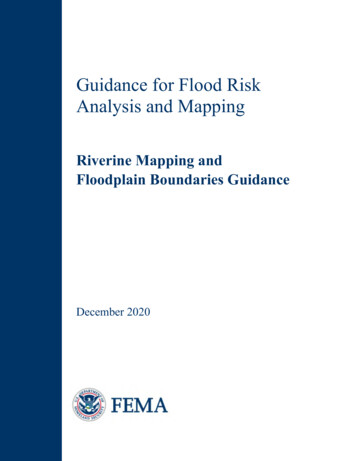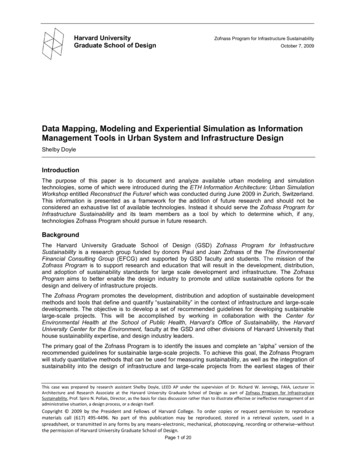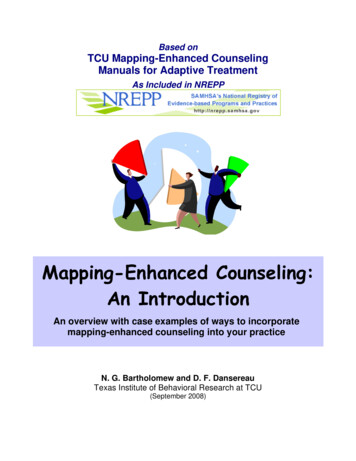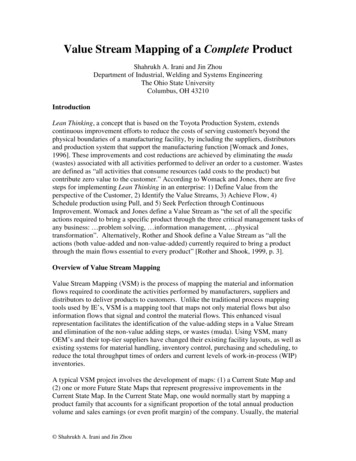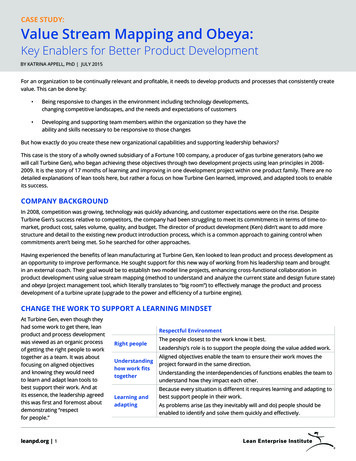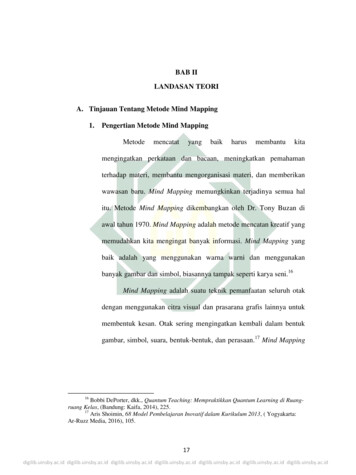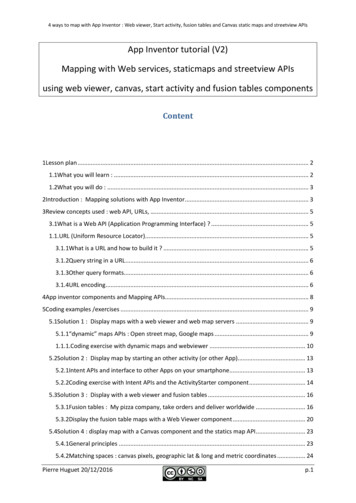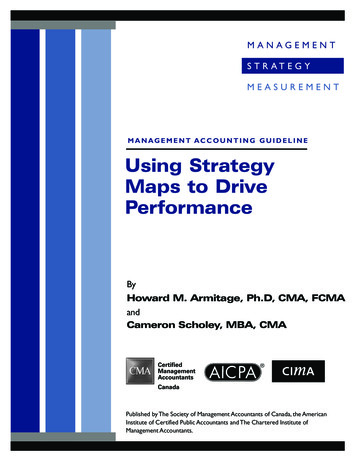
Transcription
Mapping the Types ofKnowledge Syntheses / LRsAnastasia Mallidou, RN, PhDAssistant ProfessorSchool of Nursing University of Victoria07 April 2014
Outline What is evidence (i.e., EBP), knowledgetranslation (KT), knowledge synthesis (KS) Brief history of KS, Purpose, Stages,Quality criteria for reviews Approaches & Designs SALSA framework Main types of KS (Integrative/Critical/Comprehensive,Scoping, Realist, Rapid, Systematic, Meta-analysis, Overview ofreviews)
Evidence in Healthcare source of evidence for health care is theresults of well-designed research, but suchresults are by no means the only data usedin everyday practice.“ the patient and her or his relevant others,the practitioner’s own experiences, and thenature, norms of setting/context & culturewithin which healthcare is being deliveredare all rich sources of evidence upon whichto draw in making clinical decisions.”Alan Pearson, 2007
Knowledge Translation“ a dynamic and iterative process thatincludes synthesis, dissemination, exchangeand ethically-sound application of knowledgeto improve the health of Canadians, providemore effective health services and productsand strengthen the healthcare system.”Canadian Institutes of Health Research (CIHR). Knowledge translation (2008). Availablefrom: URL: http://www.cihr-irsc.gc.ca/e/29418.html
Knowledge Synthesis - Canada“ the contextualization and integration of researchfindings of individual research studies within thelarger body of knowledge on the topic. A synthesismust be reproducible and transparent in its methods,using QN and/or QL methods. by synthesizing QN orQN results. It could a) take the form of a systematicreview; b) follow the methods developed by CochraneCollaboration or Joanna Briggs Institute (JBI); c)result from a consensus conference or expert panel.”Canadian Institutes of Health Research (CIHR). Synthesis Resources.Available from URL: http://www.cihr-irsc.gc.ca/e/36331.html
Knowledge Synthesis - Netherlands“ a strategy for combining information fromresearch with information from policy-makersand practitioners in a systematic andtransparent way in order to promote the use ofknowledge by disease prevention workers,health care providers and their professionalassociations, patients and patient groups,managers of health care, disease preventioninstitutions, health insurers and policy-makers”Bos, V., & van Kammen, J. (2007). Knowledge synthesis: A guide. ZonMw (the NetherlandsOrganization for Health Research and Development) and NIGZ (the Netherlands Institute forHealth Promotion and Disease Prevention). ISBN: 9789069282466
History of Research/K Synthesis James Lind (1747): 1st RCT Gathering research findings; getting rid ofrubbish Ian Chalmers et al. (2002): full description ofresearch synthesis discipline; methodologicaldevelopment, relevance, rigour & trade-off Growing range of designs & methods forvarious types of evidence; all follow similarapproach (variation of rigour & process)Chalmers, I., Hedges, L. V. & Cooper, H. (2002). A brief history of research synthesis.Evaluation and the Health Professions, 25, 12–37.
Why knowledge synthesis? Science is a cumulative process Independent studies may be misleading; validity,reliability, interpretation of results raise concerns(Ioannidis et al., 2005). Some reviews may be biased Few studies persuasive to change practice/policy KS: efficient, scientific approach to identify &summarize evidence for generalizability andconsistency of research & key messages KS are the cornerstone of KTIoannidis, J.P. (2005). Contradicted and initially stronger effects in highly cited clinicalresearch. JAMA, 294(2):218-28.
Purpose of KS For “knowledge support”: to summarize theevidence on a specific question/issue; notadditional tasks to support a decision For “decision support”: includes steps ofengagement with DMs for developingresearch question & synthesis protocol,interpreting and contextualizing KS results,developing (context) recommendationsCanadian Institutes of Health Research (CIHR). Synthesis Resources (2010).Available from URL: http://www.cihr-irsc.gc.ca/e/36331.html
Stages of KS ( research)All components of scientific investigation Purpose & objectives Inclusion & exclusion criteria Identify potential studies Apply pre-determined criteria Data extraction Appraisal of studies’ quality Analysis of data Structured reportChalmers, I. (2003). Trying to do more good than harm in policy and practice: The role ofrigorous, transparent, up-to-date evaluations. The Annals of the American Academy of Politicaland Social Science, 589, 22-40.
Quality Criteria in LRs1. Well-defined problem / research question(purpose & objectives)2. Explicit identification of review method(inclusion & exclusion criteria, etc.) by investigatorswith expertise in content and method3. Clear specification of review process andprotocol4. Comprehensive & explicit literature search(identify potential studies, apply pre-determined criteria)5. Explicit, unbiased, reproducible data extraction forcontent and quality (data extraction)Whittemore, R. (2005). Combining evidence in nursing research: Methods and implications.Nursing Research, 54(1), 56-62.
Quality Criteria in LRs (cont’d)6. Primary study quality considered in analysis(appraisal of studies’ quality)7. Data analysis is systematic and variability offindings addressed (analysis of data);evidence identified from primary studies8. Conclusions based on evidence and capturecomplexity of clinical problem9. Methodological limitations identifiedWhittemore, R. (2005). Combining evidence in nursing research: Methods and implications.Nursing Research, 54(1), 56-62.
KS Methods - USA of Nursing reviews Integrative review (methodological,theoretical, empirical) Systematic review, Meta-analysis (QN) Meta-summary / Meta-synthesis / Formalgrounded theory / Meta-study (QL data)Whittemore, R. (2005). Combining evidence in nursing research: Methods and implications.Nursing Research, 54(1), 56-62.
Typology of reviews - UK Critical review, Literature review, Mappingreview / systematic map Meta-analysis, Mixed studies / mixedmethods review, Overview Qualitative systematic / evidence review /qualitative synthesis, Rapid review,Scoping review, State-of-the-art review Systematized review, Umbrella reviewGrant, M. J., & Booth, A. (2009). A typology of reviews: An analysis of 14 review types andassociated methodologies. Health Information & Libraries Journal, 26, 91-108.doi: 10.1111/j.1471-1842.2009.00848.x
KS Methods - Canada from primary studies Systematic reviews of QN evidence Syntheses of QL evidence Mixed methods syntheses from broad & diverse studies Scoping reviews Multiple treatments meta-analysis/Network Meta-narrative synthesisCanadian Institutes of Health Research (CIHR). A knowledge synthesis chapter (2010).Available from: URL: http://www.cihr-irsc.gc.ca/e/41382.html
Approaches & Designs Typology: vocabulary/terminology used(literary warrant) Time (& resources) needed to complete areview Tangible processes required (SALSA)– SALSA framework: Search, Appraisal,Synthesis, AnalysisLibrarianship: role of librarian in KSGrant, M. J., & Booth, A. (2009). A typology of reviews: An analysis of 14 review types andassociated methodologies. Health Information & Libraries Journal, 26, 91-108.doi: 10.1111/j.1471-1842.2009.00848.x
Search Identify significant items (criteria?) Comprehensive: max # of primary sources;combination of at least 2-3 strategies insearching the literature (Whittemore & Knafl, 2005)– Complete: with constraints in time, scope– Purposive or selective: sampling primary studies; butjustified, explicit, well documented Extensive: more than 3 strategies Exhaustive: all known sources & strategies Systematic: comprehensive & exhaustive
Appraisal Evaluation based on contribution (?)Critical quality assessment (QA)Typical QA (without using an instrument)Formal QA (use of generic instrument)QA including sensitivity analysesTime-limited formal QA (sampling)
SynthesisSummary: summary of data without newinsightSynthesis: combine data in a way to bestanswer a pre-defined question Typical narrative (conceptual/chronological)Graphical & tabularNarrative commentaryMinimal narrative & tabular supplement
Analysis Identify conceptual contributionChronologicalNumerical: analysis of measures of effectThematic/Conceptual: may incl. conceptual modelsAssociation of QL & QN studiesMapping quantity & quality of literature; identifyresearch gaps Explanatory: What works for whom, in circumstances,in what respects & how – Combination of theoreticalviews, empirical evidence, context, mechanisms &outcomes Recommendations for practice, policy, research
Main Types of KS
Integrative, Comprehensive,Critical review or Overview* Search: identify most significant conceptsAppraisal: evaluation based on contribution Synthesis: narrative (chronological orconceptual) Analysis: identify conceptual contribution(significant component) or new theory Weakness: Open to biases*Undergraduate studies (assignment or project)
Rapid Review*(quick but not dirty) Search: CompleteAppraisal: Time-limited formal QASynthesis: Narrative & tabularAnalysis: Mapping quantity & quality of theliterature; identify direction of effect Weakness: Risk of bias*Graduate studies (assignment or project)
Scoping Review* Search: CompleteAppraisal: Informal QASynthesis: Tabular & narrative commentaryAnalysis: Mapping quantity & quality of theliterature; identify research gaps Weakness: Not a final product/output*Graduate studies (assignment or project)
Systematic Review* Search: Comprehensive & exhaustiveAppraisal: Formal QASynthesis: Narrative with tabular supplementAnalysis: Recommendations for practice,policy, research Systematized review (? Search & QA) Systematic search & review (not QA) Weakness: Answers to simple & well definedresearch questions (not for complex situations)*Doctoral studies (assignment or project
Realist Synthesis*A logic of enquiry designed to explain complex socialinterventions or programs (based on the “realist”approach) for policy-makers. Search: Complete/exploratory, purposive sampling Appraisal: Formal QA using judgement Synthesis: Narrative Analysis: Explanatory; recommendations (tentative) Weakness: Not a protocol-driven approach; explicit &reflexive QA; not generalizable effects*Doctoral studies (assignment or project
Meta-Analysis (MA)A transparent, objective, replicable statistical methodto synthesize & compare effect sizes from relevant,independent, primary, quantitative & “combinable”studies and to report a precise summary effect. Search: Systematic Appraisal: Formal QA & sensitivity analyses Synthesis: Graphical & tabular with narrativecommentary Analysis: Numerical analysis of effect Debate: Inappropriate use (“apples & oranges”)
Overview of reviews (Umbrella)“ compiling evidence from multiple SRs into oneaccessible & usable document ” Search: Systematic for SRs Appraisal: Formal QA of SRs Synthesis: Graphical & tabular with narrativecommentary Analysis: Recommendations for practice, policy,research Weakness: Currently not feasible due to the lack ofSRs on all topics.
Comparing types of KSKS/LR-typeSearchAppraisalSynthesisIntegrative /Identify mostCritical /significantComprehensive conceptsEvaluationbased oncontributionRapid ReviewTime-limited Narrative &formal QATabularCompleteScoping Review CompleteInformal apping QL& QN of lit;Identifydirection ofeffectTabular &Mapping QLNarrative& QN of lit;(commentary) Identifyresearchgaps
Next StepsInternational agreement of Discrete & mutually exclusive typology Types of reviews (criteria)– Rigour– Quality of KS– Resources needed Know-how to perform & appraise KS forimpact & influenceEBP (P: practice and policy)
Thank you!mallidou@uvic.ca31
Critical review, Literature review, Mapping review / systematic map Meta-analysis, Mixed studies / mixed methods review, Overview Qualitative systematic / evidence review / qualitative synthesis, Rapid review, Scoping review, State-of-the-art review Systematized review, Umbrella review Grant, M. J., & Booth, A. (2009). A typology of .



